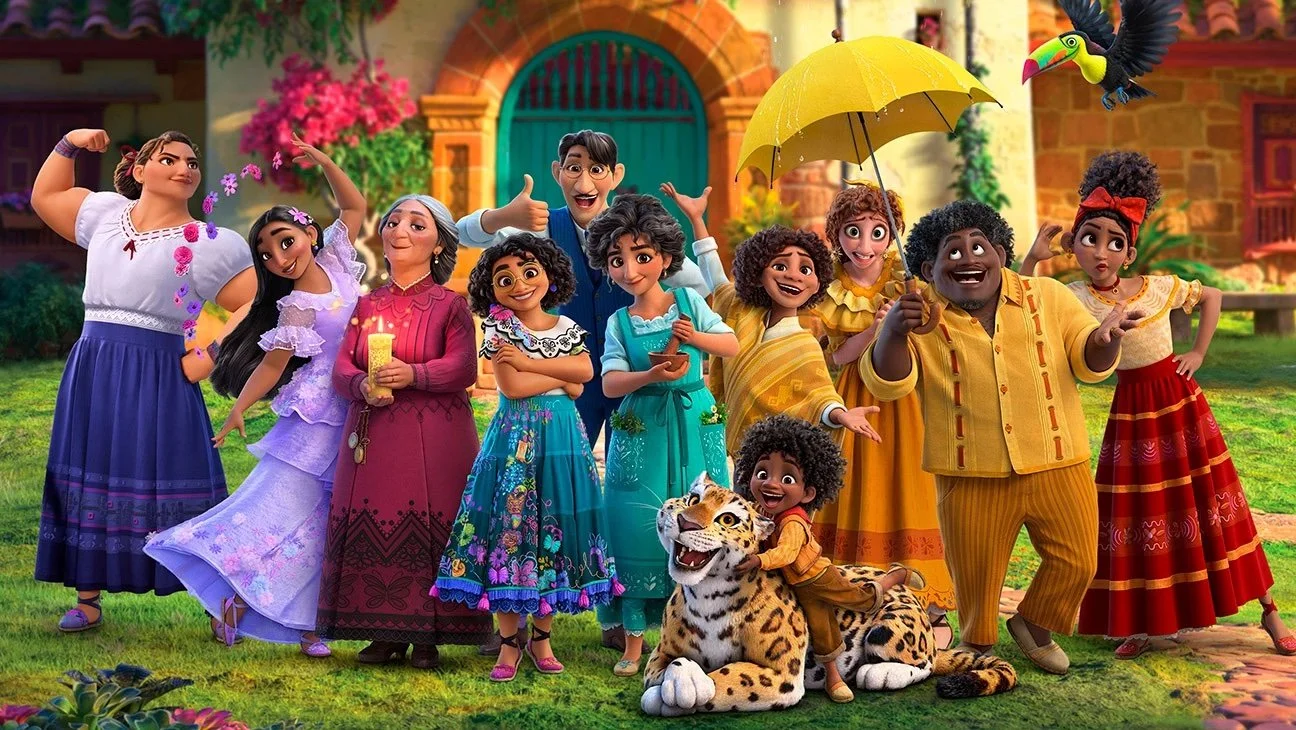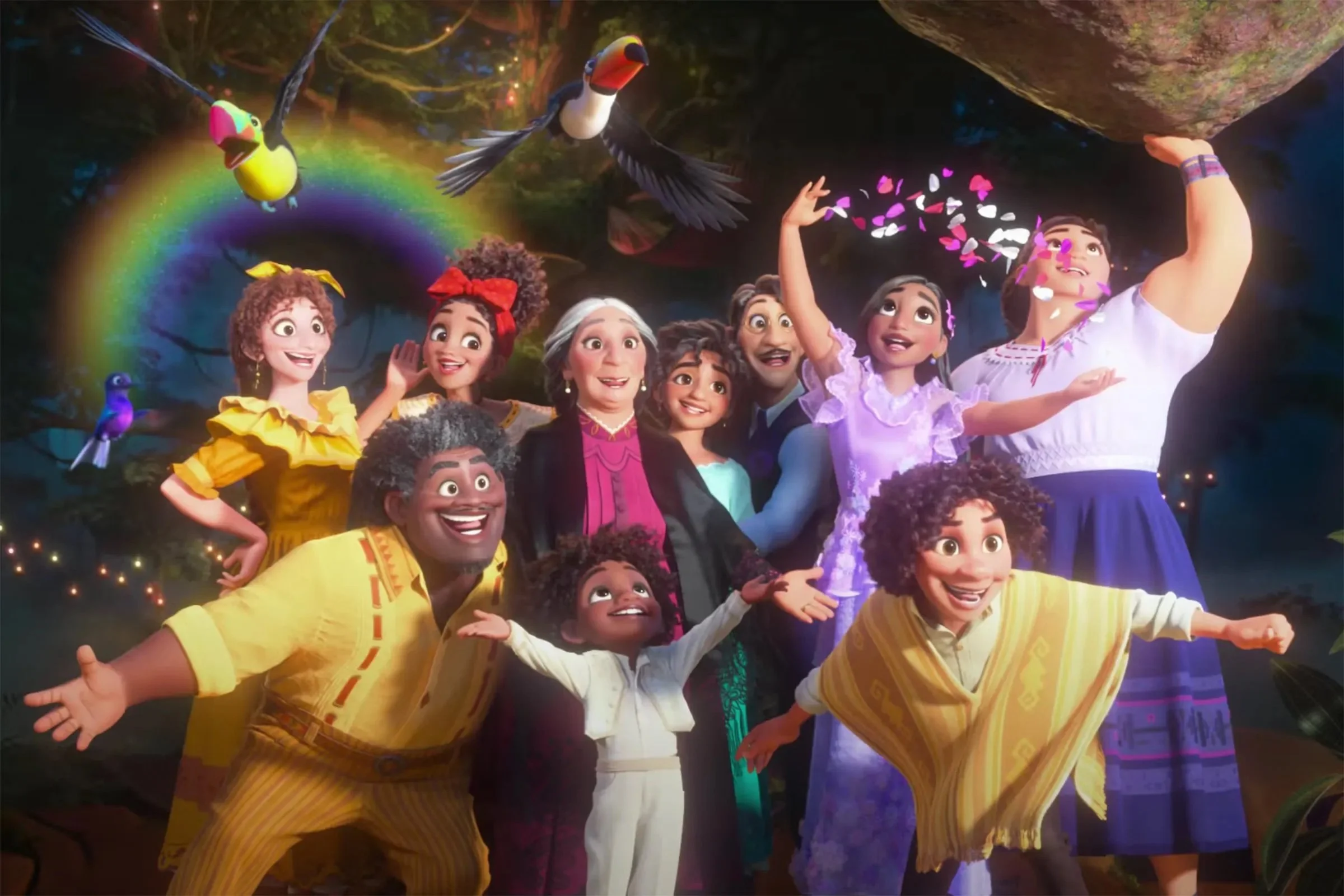The Mythology of Disney’s Encanto: A Hero’s Journey Based on Curiosity and Care
In 2021 Disney released the film Encanto. It follows the story of a magical family in Columbia. Blessed by the “miracle,” the Madrigal family all possess special abilities that they, under the supervision of their Abuela, use to help the community; everyone, that is, except Mirabel. Mirabel did not receive a gift from the magic candle. Although most of her family still accepts her, her Abuela holds her in disdain, and Mirabel is ashamed that she cannot help the family. When the family miracle and the house start to crack and fall apart, Mirabel decides she will save the miracle.
Image credit: Encanto (Courtesy Disney Studios)
Encanto is widely popular. The song “We Don’t Talk About Bruno” hit the top charts. Children responded to characters that were not white, and adults reacted to the story’s themes of toxic family behavior and intergenerational trauma. Encanto’s popularity could be attributed to many different things, but I propose that the popularity stems from the plot not following the traditional Hero’s Journey. By having a story that focuses on a heroine who uses listening and words as her tool instead of swords, Encanto speaks to our culture’s need for feminine energy.
Our culture has traditionally defined a hero as male and the heroine as female. However, as with many words, the word hero has become used and non-gendered. In old stories, the hero is seen as the strong male individual who goes on a grand quest, engages in a martial activity, and brings back a boon for the community’s well-being. His journey is an intuition into manhood’s secrets, and he emerges as the protector. Joseph Campbell brought forward the idea of this mono-myth, and Hollywood and publishers widely devoured it, the familiar structure now saturating the media consumed. Women are historically excluded from this type of journey, limited to the role of nurturer and to be the muses of men (Tatar xvi).
Image credit: Upslash
Many people have challenged this ultra-masculine view of heroism both academically and culturally. Moreover, there has been a steady rise of strong, action-oriented women characters who function exactly like their male counterparts. Though, in order to do so, they must completely disregard anything that makes them a woman. Then there are those, like Maria Tatar, who propose a different journey that women go on. In Heroine with 1001 Faces, Tatar proposes that women rely on domestic crafts, i.e., weaving and voice, to find transformation and social justice (xvii). Tatar writes that an “understanding of heroism that is driven less by empathy than by attentive care, an effect that is triggered by openness to the world, followed by curiosity and concern about those who inhabit it” (xx).
To expand the idea of the hero beyond the individual and into the community, I turn to Rollo May. In The Cry for Myth, May argues, that mythology and myths“are our self-interpretation of our inner selves in relation to the outside world. They are narrations by which our society is unified. Myths are essential to the process of keeping our souls alive and bringing us new meaning in a difficult and often meaningless world” (22). By that merit, heroes function as the souls of the community. The myth of a people is symbolized or represented by their heroes, imbued with the community’s ideas and help people find courage and wisdom (45).
Image credit: Upslash
I offer a combination of these three ideas of heroes. “A hero” is an individual who offers an individual need. “The Hero” is the soul of the community. The hero is made of the collective imaginative imagery of a community that provides meaning and understanding of the world, and this soul is not gendered. The hero and heroine difference is an antiquated binary term that we no longer have use for. Strength is associated with the masculine and care with the feminine. Why do we need to ascribe different energies that inhabit our souls and temporal bodies to our gender? Both women and men can have the hero and heroine’s energies. Both journeys are in search of different boons. Heroine energy features a protagonist led by empathy, curiosity, and concern for those around them. Encanto demonstrates that, as a culture, we desperately seek stories with the heroine energy. We need heroes that favor the energies of compassion, curiosity, and care.
Encanto is different from many other Disney films and films in general. For one thing, there is no villain or bad guy. The closest “antagonist” is Abuela, who dominates the Madrigal Family. Throughout the film and at the climax, Marble challenges her grandmother to see her toxic behavior caused by generational trauma and listen to her family’s needs. It is a journey that does not entail traveling to far-off lands, proving bravery and heroism through martial conquest and might. It does not invoke slaying a dragon, rescuing a princess, and bringing back boons and elixirs to save the community. The hero does not return with more power than before. Instead, it is a story in a house about communication within a family. Mirabel embarks on a mission to help her family. She does this by being curious, talking, listening to their needs, and ultimately showing that she cares and validates their existence as individuals and as part of a community.
Image credit: Encanto (Courtesy Disney Studios)
Mirabel only wants to be accepted and loved by her family but feels like she is a burden because she is not useful in the proscribed way. Her Abuela silences her, marginalizes her, ridicules and abuses her publicly. She does the same to the other family members, but it is more subversive, shaming them for not being strong or valuable enough. Everyone is afraid of disappointing Abuela. Uncle Bruno, a prophet, foresaw that Mirabel would cause the magic and the house to break. Because of that vision, he was shunned, silenced, and exiled.
Mirabel’s journey is about challenging toxic behaviors. Because Abuela tightly controls her family through emotional strength, she exudes too much negative hero energy. Generations ago, she saved the town and how it is her and her responsibility to keep providing for them at the expense of her family’s well-being. Abuela values strength, perfection, and usefulness. Because Mirabel does not have an obvious gift, she does not receive any of her grandmother’s reserved love. This overwhelming negative hero energy has weakened the family. There is no listening, vulnerability, and nuanced community built on care and curiosity. This is an exploitative economy where things are won by conquest and power is controlled.
Mirabel does not function this way. As an outsider, she relies on her listening skills. Only she can see how this weak hero economy is failing her, her family and the community they are supposed to be serving. No one’s needs are being met and the family is living under extreme pressure. The heroic actions of this film are to listen and affirm. When Mirabel first sets out on her quest, she exclaims, “I am going to save the miracle.” Then she laments, “How does one save a miracle?” The remainder of the movie is her asking the various family members about the miracle and if they have noticed anything wrong. Take note of the word “asking.” Mirabel exhibits curiosity about something she notices as being “off”, and she asks people and listens to what they say. Through her conversations with her family, she is forced to confront their pain and suffering. She learns about the shadows cast by the miraculous light.
Image credit: Encanto (Courtesy Disney Studios)
As Mirabel begins to listen to her family, she learns that her grandmother’s behavior is to blame. At the climax of the film, Mirabel confronts her grandmother’s toxicity. And, unlike a hero’s journey, the story does not end with the slaying of the proverbial monster. Instead, Abuela and Mirabel have a conversation. Abuela tells Mirabel about the trauma of watching her husband being murdered, her joy at the miracle given to her, and her fear that she would lose all of it. Mirabel listens and forgives. She validates the experience, confirms that Abuela saved the family, and assures her that she no longer needs to be living in those fears. This act of listening, care, and community restores the miracle to the family.
The film layers in the nuances. Mirabel comes from the Spanish word “Too See.” She can see what those with magic cannot. The house is also magic, able to move things around. Though everyone interacts with it, it is Mirabel whom the houses responds to the most. Mirabel’s image was in Bruno’s Vision that foresaw the house cracking. Mirabel is literally the house, the container of the family, the magic, the new soul of the community. Her name also translates to “to face.” Mirabel is the one who faces the hard, looks it in the face, and asks, “why?”
There is a phrase, “Curiosity killed the cat.” When applied to women, the phrase demonstrates that she should keep her mouth shut and her nose out of things. Curious women, like Eve and Pandora, get hurt. However, the second part of that rhyme is not used as much: “and satisfaction brought it back.” Yes, curiosity can lead to dark and dangerous places, but only by delving into those places can you integrate the shadow and mend the cracks of the community.
Image credit: Encanto (Courtesy Disney Studios)
In a divided country, we need more stories of curiosity and care. It is time to put aside our traditional ways of fixing things through strong martial powers. These are loud and often we cannot hear the quieter energies of the soul because of the clanking armor. It is clear we want to speak, listen, give, and receive compassion as a community. It is time to befriend the dragon, not kill it. In order to confront our history of abuses, colonialism, oppression, and violence, we have to embrace our shame and empower our curiosity. One way that we grow more powerful in these areas is by continuing to tell stories about souls who exhibit these types of caring and curious journeys, we need more Mirabels.
Works Cited
Encanto. Directed by Byron Howard, Jared Bush, Charise Castro Smith, Disney, 2021.
May, Rollo. The Cry for Myth. Apple Books, W.W. Norton & Company, Inc., 1991,
Tatar, Maria. Heroine with 1,001 Faces. Liveright Publishing Corp, 2021.





